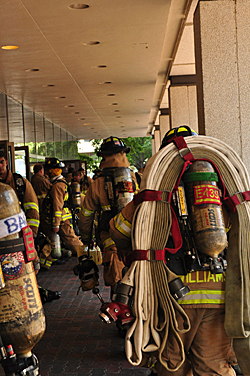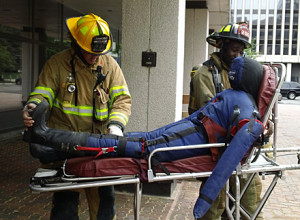When responding to fires in high-rise buildings, firefighting crews of five or six members—instead of three or four—are significantly faster in putting out fires and completing search-and-rescue operations, concludes a major new study carried out by the National Institute of Standards and Technology (NIST), in cooperation with five other organizations.
Results of the study, conducted with 13 Washington, D.C.-area fire departments, were presented at the 2013 Metropolitan Fire Chiefs Conference in Phoenix.
“Unlike most house fires, high-rise fires are high-hazard situations that pose unique operational challenges to fire service response. How big a fire gets and how much danger it poses to occupants and firefighters are largely determined by crew size and how personnel are deployed at the scene,” says lead researcher Jason Averill, a NIST fire protection engineer. “It’s not simply that larger crews have more people. Larger crews are deployed differently and, as a result, are able to perform required tasks more quickly.”
 An analysis of 14 “critical tasks”—those undertaken when potential risks to building occupants and firefighters are greatest—found that three-member crews took almost 12 minutes longer than crews of four, 21 minutes longer than crews of five, and 23 minutes longer than crews of six to complete all tasks. Four-person crews took nine minutes and 11 minutes longer than five- and six-member crews, respectively.
An analysis of 14 “critical tasks”—those undertaken when potential risks to building occupants and firefighters are greatest—found that three-member crews took almost 12 minutes longer than crews of four, 21 minutes longer than crews of five, and 23 minutes longer than crews of six to complete all tasks. Four-person crews took nine minutes and 11 minutes longer than five- and six-member crews, respectively.
The study also looked at the effect of using fire service access elevators to move firefighters and equipment up to the staging floor and concluded that most tasks were started two to four minutes faster when using the elevators compared with using the stairs.
The study, funded by the Federal Emergency Management Agency (FEMA) Assistance to Firefighters Grants Program and conducted in a 13-story vacant high-rise office building in Crystal City, Va., involved 48 separate controlled experiments, plus 48 corresponding computer-modeling simulations, which evaluated three types of representative fires, from slow to fast growing.
“This study will result in better-informed policy and operational decisions influencing levels of staffing and other resources available for responding to high-rise fires,” says Dennis Compton, former chief of the Mesa, Ariz., fire department and chairman of the board of the National Fallen Firefighter Foundation. “These are decisions now confronting hundreds of communities across the country.”
On the basis of the results of computer modeling, which incorporate data from live experimental burns, the study team concluded that smaller crews end up facing larger fires because of the additional time required to complete tasks.
A three-person crew, for example, would battle a medium-growing blaze that is almost 60 percent larger than the fire faced by a six-member crew, which would start extinguishing a fire roughly three-and-one-half minutes earlier. In an office building, this difference is equivalent to four employee cubicles on fire for a three-person crew versus two cubicles for a six-person crew.
Comparing the performances of different-sized crews, the researchers found that adding two members to three- and four-person teams would result in the largest improvements in starting and completing critical tasks, such as advancing the water hose to the fire location and beginning search and rescue. Improvements ranged from one minute to 25 minutes, depending on the task.
The research team also evaluated whether dispatching more three or four-member crews to a high rise fire—accomplished by sounding a higher initial alarm—would be as effective as sending a low first alarm contingent of engines and trucks staffed by more firefighters. They found that a “low-alarm response with crews of size four or five outperforms a high-alarm response with crew sizes smaller by one firefighter.”
“Prior to this experiment, some fire departments attempted to deploy with smaller crews on each piece of apparatus,” explains Lori Moore-Merrell of the International Association of Fire Fighters, a co-principal investigator for the study. “The logic suggested that, if the fire is big enough, just send more units, but it ignores the fact that larger crews have tactical advantages that reduce risk exposure to people and firefighters. Crews of six and even five can carry out crucial tasks in parallel rather than in series. Saving time can save occupant lives and prevent firefighter injuries and property damage.”
The National Fire Protection Association (NFPA) defines high-rises as buildings that are seven stories or taller, the height that exceeds most types of fire service ladders. In most U.S. communities, new high- rises are required to have automated sprinkler systems, which are designed to control the spread of fires, not to extinguish them.
 But according to the NFPA, 41 percent of U.S. high-rise office buildings, 45 percent of high-rise hotels, and 54 percent of high-rise apartment buildings are not equipped with sprinklers, as compared with 25 percent of hospitals and related facilities. Moreover, sprinkler systems fail in about one in 14 fires.
But according to the NFPA, 41 percent of U.S. high-rise office buildings, 45 percent of high-rise hotels, and 54 percent of high-rise apartment buildings are not equipped with sprinklers, as compared with 25 percent of hospitals and related facilities. Moreover, sprinkler systems fail in about one in 14 fires.
As a result, Averill says, “fire departments should be prepared to manage the risks associated with unsprinklered high-rise fires regardless of whether a building is actually sprinklered.”
High-rise buildings now dot the U.S. urban, suburban and even rural landscapes. While concentrated in large cities, such as New York with 6,543 skyscrapers and buildings seven stories or taller, Chicago with more than 2,300, and Phoenix with about 175, high-rises are also common in smaller metropolitan areas, according to the building inventory maintained by Emporis. For example, Omaha has about 70 buildings seven stories or taller, Fargo, N.D., has 22, and Gulf Shores, Ala., has about 65.
While much less frequent than house fires, about 43 high-rise fires occur in the United States every day. Between 2005 and 2009, according to the NFPA, high-rise structure fires averaged 15,700 annually. Average annual losses totaled 53 civilian deaths, 546 civilian injuries and $235 million in property damage.
The new study on responding to high-rise fires complements a 2010 study from the same research team that looked at staffing levels and arrival times in the context of fighting residential fires.**
“Rather than providing a one-size-fits-all answer, our study provides a scientific basis for discussions in communities as they consider matching resources deployed to their particular risk levels.” says Averill.
“Until now, high-rise staffing, deployment and even operational decisions have been based on decades of applying trial and error strategy and tactics,” says NFPA’s Russell Sanders, a retired Louisville, Ky., fire chief. “Tragically, the fire department standard operating procedures and industry standards that we have today have, in many cases, been established at the high cost of civilian and firefighter lives: the science to prove these policies, procedures and standards as the best practice has been absent.”
Sanders says NFPA consensus committees will use the results of the new study as they update safety and best-practice standards for firefighters.
Description of experiments: http://www.nist.gov/el/fire_protection/high-rise-fire-study-experiments-041013.cfm
Photo Credits: IAFF

